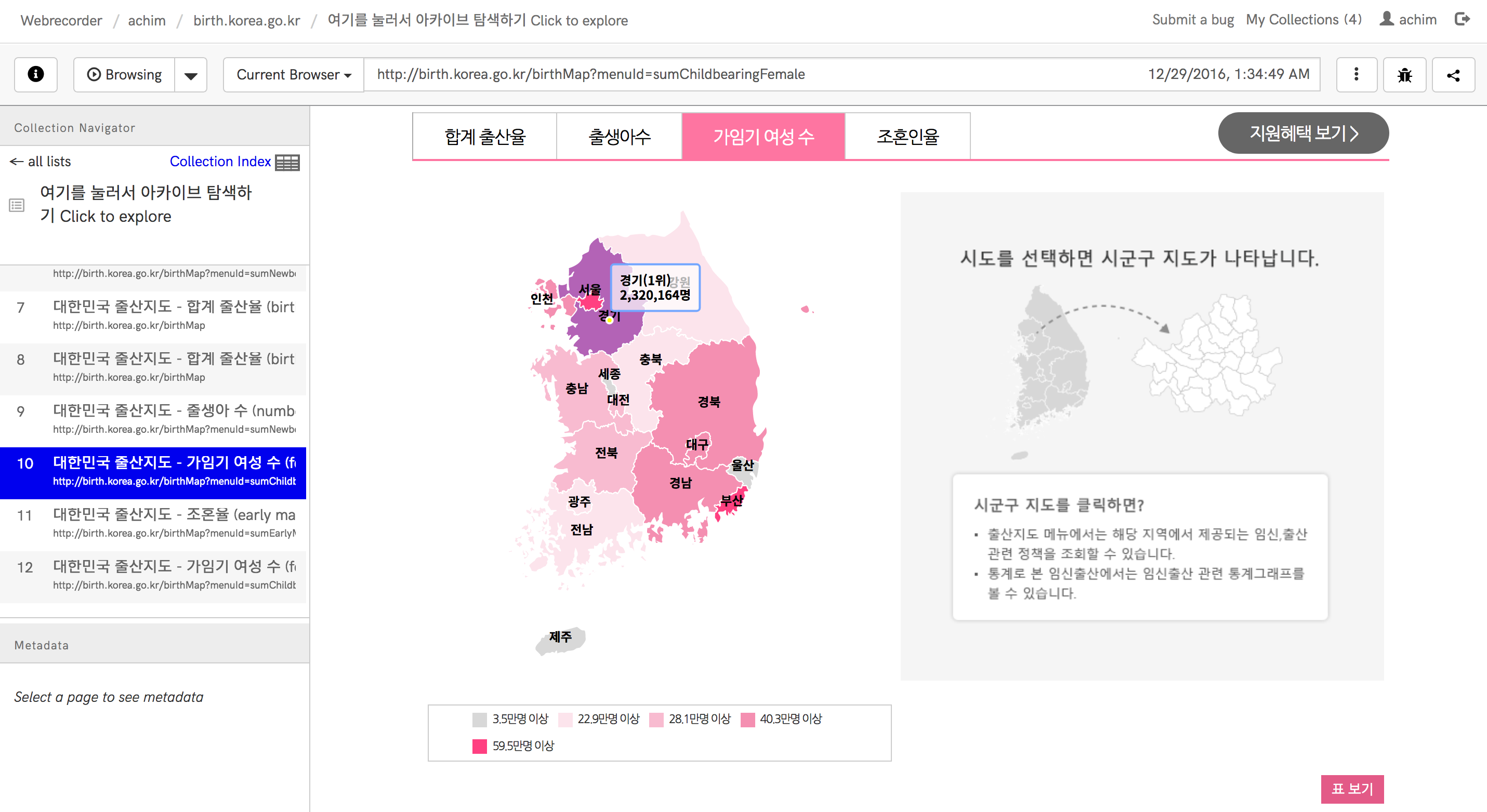대한민국 출산지도 저장본
2018-12-29

link: https://webrecorder.io/achim/birthkoreagokr
2016년 12월 29일 행정자치부가 “대한민국 출산지도” 웹사이트를 런칭했다. 소개 페이지에서는 사업 취지를 “출산율 저하로 인구감소 위기에 대응하기 위해 국민들에게 지역별 저출산 문제 심각성을 알기 쉽게 알려주고 저출산 극복을 위해 다함께 참여하는 분위기 조성”이라고 설명했다. 이 웹사이트는 출산율 관련 통계와 정책 정보에 더해 “출산지도”라는 인터랙티브 데이터시각화 지도를 선보였는데, 시각화된 통계자료 중 하나로 지역별 가임기 여성 수가 있었다.
지역별 가임기 여성 수 시각화는 유독 많은 관심을 받았고, 공공 캠페인에 이 자료를 포함시키기로 한 결정이 정부의 저출산 문제에 관한 독단적 인식을 드러내는 것으로 보였다. 지역 간 숫자를 단순히 비교하는 식의 자료 공표가 지방자치단체들에게 가하는 압력이기도 하고, 더구나 (출산할 수 있는데도 하지 않음으로써 국가적 문제를 유발한) 가임기 여성에 대한 비난 돌리기로 읽힐 수도 있기 때문이다. 하지만 가장 큰 문제 지점은 가임기 여성을 비효율적으로 사용되고 있는, 따라서 동원이나 활용의 대상이 되어야 하는 일종의 자원 정도로만 보는 듯한 인식일 것이다.
출산지도가 공개되고 얼마 지나지 않아 이 허핑턴포스트 기사에 기록된 것처럼 트위터 등지에서 비판이 제기되었다. 지금은 삭제된 행정자치부의 홍보 트윗 아래 달린 답글을 보면 당시의 분위기를 더 생생하게 느낄 수 있다.
출산지도 웹사이트는 공개된 당일인 12월 29일 서비스가 중단되고 시스템 점검 오류 메시지를 표시하기 시작했다. 지금은 존재하지 않는 사이트지만, 문제의 출산지도를 포함해 일부 페이지들은 이 묶음에 저장되어 있다. (하나씩 저장하던 중 웹사이트 서비스가 중단됐다)
인터랙티브 지도가 안 보이면서 에러가 뜰 때는 상단 주소창 바로 왼쪽 옵션에서 브라우저를 Current Browser나 파이어폭스(v49) 에뮬레이터로 설정하면 해결된다.
함께 보면 좋은 자료
- 한겨레 팔로업 기사. ‘가임기 여성지도’ 이렇게 탄생했다. 정유경.
- 페미위키 관련항목. 대한민국 출산지도(행정자치부)
A government-produced visualization of fertile women
The South Korean Ministry of the Interior (MoI) launched birth.korea.go.kr, a website that aimed to promote public awareness about the country’s population decline, on Dec 29, 2016. The website provided birth rate-related statistics and policy information, and featured a “Birth Map” interactive data visualization that displayed, among other statistics, fertile female population by municipal region.
This last statistic proved especially problematic. In addition to being not very informative (the absolute number of women was visualized, which provides little insight given that South Korea regions vary vastly in terms of surface area and population density), the decision to include this particular information in a public-oriented campaign seemed to reveal the government’s dogmatic perspective on population decline. First, the public announcement of such a statistic and regional comparisons serves as a top-down pressure on municipalities to ‘improve their numbers’; second, it can also be read as an indirect blame-shifting towards women, who despite being fertile chose not sufficiently enough to give birth, leading to the national problem. Perhaps most problematic of all is the understanding of fertile women as underutilized resources that need to be mobilized or exploited.
The website quickly became the subject of Twitter public outrage, like the tweets archived in this Huffington Post Korea article or under the now-deleted tweet from the MoI announcing the map.
The website was taken down the same day, displaying a “system maintenance” error message. This collection is a partial collection of the original website (it was taken down while I was archiving it).
The interactive map may not display properly, and show an error message instead; choosing the Firefox v49 emulated browser or Current Browser in the option left to the address bar could fix it.